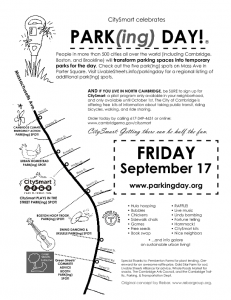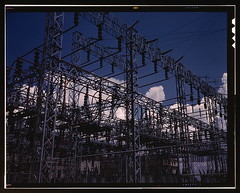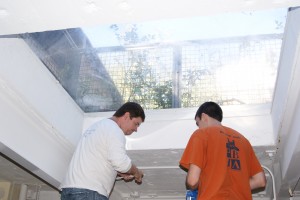In a recent post by GOOD, a detailed breakdown of 2008 energy consumption in the US illustrates the range of energy use across the country by state. According to this data, Massachusetts comes in with 1.00 – 1.49 quadrillion BTUs of total energy consumption, while California or Texas, for example, come in at more than 2.50 each. The graph also breaks down total energy consumption by person, or per capita. How does your state measure up?
Category Archives: Cambridge
The Fate of Vermont Yankee
The Vermont Yankee nuclear power plant, located in the town of Vernon on the boarder of Massachusetts and Vermont, has been a topic of environmental concern and debate for many years. On Sunday, November 7th, the plant shut down due to a cooling water leak, but was back online to the New England grid early next Thursday morning.
Local residents and politicians, fearing the dated, aging plant could lead to potential nuclear disaster, have been pushing to permanently close the plant for years. In fact, the consensus in the Vermont Legislature is that Vermont Yankee should be closed when its 40-year license expires in March, 2012. Entergy, the Louisiana-based power company that owns the plant, has since put the reactor on the market as of last week given the continued resistance by the state of Vermont. Nonetheless, the fate of Vermont Yankee remains somewhat unclear.
The Brattleboro Reformer reported Thursday that in nearby Keene, NH, city officials are debating whether to sign a letter asking to be involved in decisions on how the reactor would be torn down. Clearly the push to close Vermont Yankee is significant, particularly when neighboring states express concern and take action. The question however remains: if Vermont Yankee shuts down, what alternative energy source will take its place? For now, the focus is the closure of an archaic power plant. What would ensue remains open for discussion and debate.
Green Medford: Reverse Trick or Treat Bewitches Columbus School Neighborhood
 What would you do if your doorbell rang on Halloween and instead of saying “trick or treat!” your visitors handed you a new, curly-cue light bulb (or two)? This year’s Halloween saw an event that was a brand new take on the usual compact fluorescent light bulb canvasses that the CEA hosts. We are thrilled to see that this creative event went off without a hitch, and that it has set a great precedent for following years!
What would you do if your doorbell rang on Halloween and instead of saying “trick or treat!” your visitors handed you a new, curly-cue light bulb (or two)? This year’s Halloween saw an event that was a brand new take on the usual compact fluorescent light bulb canvasses that the CEA hosts. We are thrilled to see that this creative event went off without a hitch, and that it has set a great precedent for following years!
Please see below for the post featured on the Green Medford blog:
A group of us from Green Medford and Fletcher Green (a Tufts graduate student group) trolled the streets around the Columbus School last night–Halloween evening–handing out bags of treats to delighted and laughing residents at 84 addresses. People who answered their doors expecting to give out candy were instead handed a bag containing two new energy-efficient lights. Event participant “Sherlock Holmes” noted, “It was gratifying to see how surprised and happy this made people.”
One resident told us, “This is such a great idea! We recently switched all of our bulbs to CFLs and are saving $60 a month.” She turned to her neighbor and said, “You have to take some. This is amazing!”
We gave out more than 180 CFLs that were donated by National Grid and the Tufts Office of Community Relations. The First Annual Medford Reverse Trick or Treat exceeded our expectations, and we are already looking forward to expanding on our success with a bigger event next year!
Thanks so much to all the sponsors and others who helped organize this event, especially JR Siegel, Allie Lipps, Becky Hemperly, Kim Wardwell, Catherine Smith, Alicia Hunt, Brad Steele of EFI, and Barbara Rubel at the Tufts Office of Community Relations.
Susan Altman
Green Medford
MIT Climate CoLab Contest
![]() What should we do about climate change?
What should we do about climate change?
Instead of waiting for policy makers to act, you can help figure out the answer at the Climate CoLab; previously discussed in Opening the [Copenhagen] talks. Working alone—or in teams of people from all over the world—you can create proposals for what to do about climate change. The winning proposals will be presented to key policy makers, including officials at the UN and the US Congress. And if your proposal is one of the top two, you’ll receive travel funding for a representative of your team to attend one of these briefings.
We especially encourage entries from teams of undergraduate and graduate students with an interest in climate and sustainability issues. As usual rules and restrictions apply.
The deadline for the contest is October 31, 2010.
Reverse trick-or-treat CFL event!
 The Cambridge Energy Alliance has participated in many CFL exchange canvasses. On a chosen day, we and volunteers head out into neighborhoods and knock on doors, offering to give an equal number of CFLs for the number of regular light bulbs a household will hand us. As a special treat with Halloween approaching, Green Medford has announced an event that is a new take on this idea.
The Cambridge Energy Alliance has participated in many CFL exchange canvasses. On a chosen day, we and volunteers head out into neighborhoods and knock on doors, offering to give an equal number of CFLs for the number of regular light bulbs a household will hand us. As a special treat with Halloween approaching, Green Medford has announced an event that is a new take on this idea.
From the Green Medford blog:
Hi all! I want to share with you a very fun idea and ask for your help in making it a big success!
We’re calling our event “Reverse Trick or Treat,” thought up by JR Siegel, a student at the Fletcher School and a Medford resident. The idea is for a bunch of residents to get together on Halloween, hopefully including kids, to make it more fun for everyone.
Dressed in fun costumes (but nothing too scary), teams of two or three (no kids without an adult) will ring doorbells in a residential neighborhood during trick or treating time. We’ve been given several hundred energy-efficient lights (CFLs) by National Grid and Tufts to give away to folks who answer their doors. The more of us there are to participate, the more bulbs we can give out. The kids, of course, will do regular trick or treating at the same time!
We want to focus on a neighborhood with lots of families that might not already have CFLs or know all they need to about saving electricity and money by switching to energy-efficient lights.
We also would like to find a reporter to walk around with us and take pictures and talk to people about the event.
In addition to us in Green Medford, we already have all these sponsors committed!
EFI/National Grid, Tufts University Office of Community Affairs, Fletcher Green (a student group at Fletcher School of Law and Diplomacy/Tufts), and the Medford Energy and Environment Office.
Please join us! Contact Susan Altman, Green Medford, susan.altman@comcast.net, 781-395-4664, or J.R. Siegel, Fletcher Green, j.r.siegel@gmail.com.
Happy Halloweeeeeeeen!
Touring the Casella Recycling Plant

The front of the warehouse, where trucks unload.
First, giant piles of recyclables are dumped off the trucks and bulldozed onto a conveyer belt, which levels them out into more manageable amounts.

A teeny tiny bulldozer pushes the recyclables onto a conveyer belt.
Then the mass of recyclables are spun around a tunnel with 1-inch holes in the sides. Centrifugal force holds lighter materials to the side while glass falls to the bottom and shatters, over and over again, until it can fall through the holes.
Heavier metals (pots & pans…) and rigid plastic (like laundry baskets) are pulled out by hand and dropped into chutes. More than 20 people are stationed at various spots on the line to hand sort, but 99% of their job is to pull out plastic bags before they can gum up the works.
A magnetic conveyer belt runs over the line to pull out metal. Since aluminum isn’t magnetic, a later spot in the line reverses the polarity of the aluminum to repel it over a barrier and onto another belt.
Paper and cardboard slides up rollers spaced at intervals. The paper glides over the top of the rollers, but heavier materials like plastics fall through. It’s amazing how well sorted everything is by the end of the line.
Eight sets of optical sensors ID different kinds of plastics and trigger jets of air to shoot them over a barrier onto another belt.
The end results are baled for transport. The system works remarkably well: the plant director told us that their buyers only allow 2% contamination of each material with another, so it has to be well sorted. Anything that didn’t get separated is run through the system again to capture as much as possible.

Bales of recycling are stacked way over your head.
I expected the warehouse to stink, but it didn’t. I guess that’s a testament to how well people rinse their recyclables. But it was very noisy and very dusty. And hot! I guess an 80-degree day wasn’t the best for a tour.
Some take-aways for me:
- Plastic bags are death to the machines. The line is only running about 70% of the time, mostly because of plastic bags. So don’t toss them into recycling bins.
- Plastic smaller than 3 inches falls through and doesn’t get recycled. So bottle caps should always be put back on their bottles.
- Paper attached to glass gets thrown away, because tiny glass particles stick to it at the plant. So if you want to recycle it, pull it off at home.
If you’re interested in going on a tour yourself, Cambridge is hosting two more this year, on October 28 and November 18. To sign up, email recycle@cambridgema.gov or call 617-349-4815. If you can’t make the tour, you can also watch a video about single-stream recycling on Casella’s website.
For all the pictures, and larger versions of them, see the original article at the link below.
Cross-posted on pragmaticenvironmentalism.comPerson-to-Person Car Sharing with RelayRides

The RelayRides onboard computer
Jason and I are thinking of enrolling our car, since we rarely use it on weekends, but we wanted to try out the system from the other side first.
Like with Zipcar, a membership card locks and unlocks the door, but only during your scheduled time. An electronic device near the rearview mirror shows how long you have the car for and allows you to extend or shorten your reservation. It also houses the gas card. Gas is the owner’s responsibility (figured into the cost of the rental), but drivers are supposed to make sure they return it at least ¼ full.
When I signed up, I got a $25 credit on my account, to encourage me to use it. It’s such a new service that they’re also waiving any introductory fees, so it’s cost us nothing. If you’ve ever thought of using Zipcar, it’s worth trying out.
The whole thing’s remarkably easy, but there were a few hangups. The door unlocking mechanism was a little touchy; I had to hold the card against it longer than I thought necessary before it registered. And we did have a little bit of trouble finding the car. Unlike Zipcar, the only RelayRides sign around the car is in the bottom corner of the windshield, and the website showed a silver Honda Accord, when the car was blue. That wouldn’t have been so confusing, except a silver Honda Accord was actually parked nearby. Luckily, the owner of the car came out while I was calling the company and pointed out the correct car.
Despite that, though, the whole thing was so positive that it even convinced Jason that we should sign up, and he’s not always up for my cockamamie schemes. Once our car’s enrolled, I’ll let you know how it works from that side, too.
Greening America’s Capitals – Boston and Hartford
 As recently reported by GreenBiz, Boston and Hartford have been chosen by the Environmental Protection Agency (EPA) as two of the five cities that will partake in the Greening America’s Capitals program. This is great news as it means a team of EPA backed designers will visit each city and will create and design plans that promote smart growth and will help ensure the future sustainability for both capitals.
As recently reported by GreenBiz, Boston and Hartford have been chosen by the Environmental Protection Agency (EPA) as two of the five cities that will partake in the Greening America’s Capitals program. This is great news as it means a team of EPA backed designers will visit each city and will create and design plans that promote smart growth and will help ensure the future sustainability for both capitals.
In conjunction with the U.S Department of House and Development and the U.S. Department of Transportation, the EPA will provide all five cities with plans for “high-quality green development that includes cleaning up and recycling vacant lands, accessing and improving waterways, providing greater housing and transportation choices, and reducing infrastructure and energy costs.”
Specifically, the press release notes that Boston “asked for assistance through EPA Greening America’s Capitals to create realistic greening options for City Hall Plaza that can be realized in the near term. Goals of the redesign will be to create well-defined edges and entrances, provide more bike access and parking, connect the plaza to existing streets, increase green elements such as trees and vegetation for better stormwater management, and support energy efficiency and green building improvements in City Hall and nearby buildings.”
As for Hartford, the program “will help Hartford staff and stakeholders create a redevelopment plan for the Capitol Avenue corridor and connections to nearby locations, such as the Frog Hollow neighborhood and a proposed Sigourney Street bus rapid transit station. Redesigns will focus on public open spaces, such as parks and state building grounds, as well as green street improvements that better manage stormwater, improve the pedestrian environment and aesthetic character of Capitol Avenue, and encourage future redevelopment.”
Along with Boston and Hartford, the three other cities chosen to receive this award are Charleston, WV, Jefferson City, MO, and Little Rock, AK. These cities beat out numerous others for this assistance and we are thrilled that of the pilot cities, two are GreenScene cities in New England. Congratulations to all the five capitals!
Report from a weatherization barnraising
Q-lon is foam weatherstripping in the shape of a V attached to a wooden or metal slat. The V expands to fill any open space between the doorjamb and the door—a lot like the V-channel weatherstripping that we use for our windows. When I found out about the Q-lon last time, I still didn’t know quite how to install it, so I was glad to get the chance. HEET actually has a really good tutorial that walks you through the basics. The most important part is making sure the foam isn’t too compressed or too slack. You do this by sliding a piece of paper between the weatherstripping and the (locked) door. If the paper doesn’t fall out when you let go, it’s tight enough. If it comes out when you pull on it, it’s loose enough.
I’m especially interested in this because the self-adhesive foam weatherstripping that we used last year compressed a lot. I don’t know how effective it is anymore. Since the Q-lon is installed on a different part of the doorjamb, we can keep the foam and just add this to it. It’s a much more permanent solution.
It does require some hacksawing, though, to cut the slats down to the size of your door. This may have been the first time I’ve ever used a hacksaw in my life, and I’m proud to say that I got the hang of it after just a couple of ragged edges.
Jason got to use spray foam on the cracks around the skylights. This is only the second time he’s used it, and he picked up some tips. First, wear goggles and gloves, and hold something under the can so it won’t drip anywhere. That stuff never comes out. Second, shake it for a long time, then spray it into a trash can until you get a sense of how fast it comes out. It can expand like crazy. You can cut it down with a razor blade once it’s dry, but it’s easier to not have to. Make sure you have a lot of cracks to fill, though—once you start the can you can’t store it to use again later.I’ve really enjoyed these weatherizations, and I’d definitely do another. I like the idea that the energy savings that the homeowners see will be multiplied by the skills the volunteers learn to use in our own homes. And it’s nice to meet like-minded neighbors (even the crazy ones).
Cross-posted on pragmaticenvironmentalism.comPARK(ing) Day
 Warm Home Cool Planet is(was) temporarily offline. You might also be interested in the local PARK(ing) Day festivities (PDF).
Warm Home Cool Planet is(was) temporarily offline. You might also be interested in the local PARK(ing) Day festivities (PDF).




